QuestionQUESTION: I also rescue feral cats and kittens in N Cyprus where the average cat is actually of Turkish origin including Angoras, and Turkish Vans sometimes of Show quality and help to combat the dangerous inbreeding and small gene base present in the cat fancy. They are worth a little extra effort.My neighbours complain bitterly that I feed my cats cooked chicken heads and liver in addition to the highly questionable dry stuff.I think just these 2 items will improve their nutrition and health immensely. The chicken heads contain lots of soft bones for the calcium and is high in complex animal protein. Countering interference from ignorant people is a full time job, It would be good to get a nutritional analysis of cooked chicken heads.
ANSWER: Hi Harvey,
The livers are okay, but I would discourage feeding the chicken heads. Wings would be better. In either case, any parts containing bones should be fed completely raw. Cooking not only robs the meat and bones of much of its nutritional content, but it causes the bones to become brittle. This can cause irritation and even a perforation of the gastrointestinal tract. As for the actual nutritional value of the items you're feeding, I don't have a guaranteed analysis, but brains don't provide much nutritional value, since they're nearly all water. The bones can be a helpful source of calcium if left uncooked.
Best wishes!
Jessica
---------- FOLLOW-UP ----------
QUESTION: This answer just vanished first time round, so better to repeat it.
I'm surprised that chicken brains provide so little nutrition. Well, there is the expression "chicken-brained".
I prepare the heads in a pressure cooker and the bones are very soft. They get everything from the pot including the jelly.One of my white blue-eyed kittens is a very fussy eater and really is only interested in chicken liver which has no calcium at all. I mix liver and gravy with the regular dry stuff and a spoonful of yoghurt and she eats a fair bit of that. She doesn't eat chicken heads, necks, or breast , tasty canned food or even cheese!! It is also almost impossible to pop a piece of cheese into her mouth or anything else for that matter. So she is a bit of a problem. I am wary of canned tuna because of the mercury. Next step is to try sardines mixed with the dry food.
Many thanks.
ANSWER: I'm glad you sent your answer again, I didn't receive it the first time. Hopefully the dry food they're eating is providing enough calcium for them, since dry food is a balanced diet. Preferably, unbalanced treats such as the livers and chicken heads shouldn't make up more than 15% of their diet.
As for the mercury in tuna, cats are quite resistant to it. They can tolerate at least ten times more mercury than humans can, per pound of body weight. But they suffer another problem when fed too much fish of any sort - Vitamin E depletion. This can lead to a condition called steatitis, or Yellow Fat Disease, which is a hardening of the fatty tissues that causes extreme pain, fever and may lead to death if not treated. To avoid this, it's best to feed fish three times a week or less.
I admire the special care you take of the kitties. Keep up the good work!
Jessica
---------- FOLLOW-UP ----------
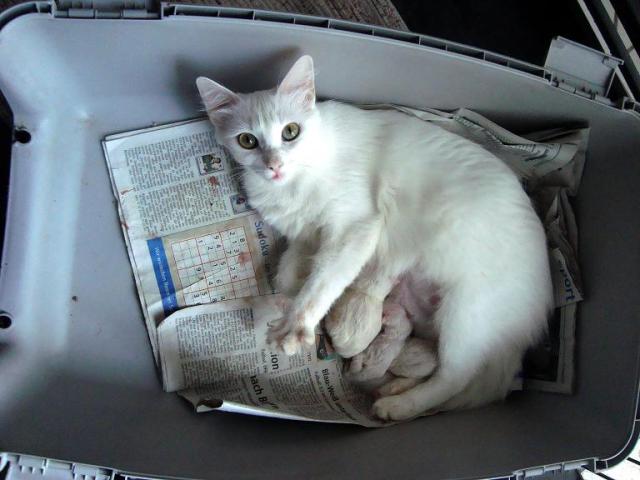 Messalina, 23 Aug 10
Messalina, 23 Aug 10
QUESTION: This time it's a lot more serious.
My white Aphrodite female cat Messalina gave birth to 3 white kittens. One healthy living female and 2 sickly boys that both died.
The boys wre much smaller than the girl. Soon they developed colorless lesions on the skin, Their abdomen turned bluish, got very cold, stopped feeding and soon died . There was a black exudant from their anuses which looked like de-oxygenated blood.
For a time they accepted artificial feeding but it seemed to stay in their stomach and not be digested.
Could this be blood group incompatability? Why only the boys?
AnswerSo sorry to hear about the little ones. Blood group incompatibility is a possibility. This can cause a condition known as Feline Neonatal Isoerythrolysis (NI). NI can take entire litters or just a few kittens within a litter, because not every kitten's body will be affected so badly by the B antibodies. In fact, some kittens born to parents with conflicting blood types won't have any symptoms at all. It really is an individual response, and unfortunately, there is no way to predict how well an A-type kitten will recover once exposed to a B antibody. After the first 48 hours of nursing, however, the threat has generally passed, and if she survives the first two weeks, she is likely to pull through.
One other condition I'm a little concerned about is a virus called calici. In the last few years, a new strain has emerged that is extremely virulent and is much more deadly than the other strains, which only tend to cause upper respiratory problems and mouth sores, or pneumonia in the worst cases. This new strain, called Virulent Systemic Calicivirus (VS-FCV), causes organ failure, often of the gastrointestinal tract. It can also cause ulcers on the body, which tend to disfigure any cats who survive. Massive outbreaks of VS-FCV have occurred in a few confirmed areas throughout the US and UK, but it's believed isolated cases pop up elsewhere because of calici's ability to mutate so easily.
It might also be possible that the mother could be responsible for the babies' deaths. Rasping away at the skin with her tongue could be responsible for the lesions, and causing trauma to the belly with bites may be the reason the bellies were blue, and why they had either blood or liquid feces draining from their anuses. She may have done this because they were obviously underweight and sickly.
Because I'm not a vet, I can't say what could have killed the babies for sure. These would be my most likely explanations, however.
Best of luck with the remaining little girl!
Jessica


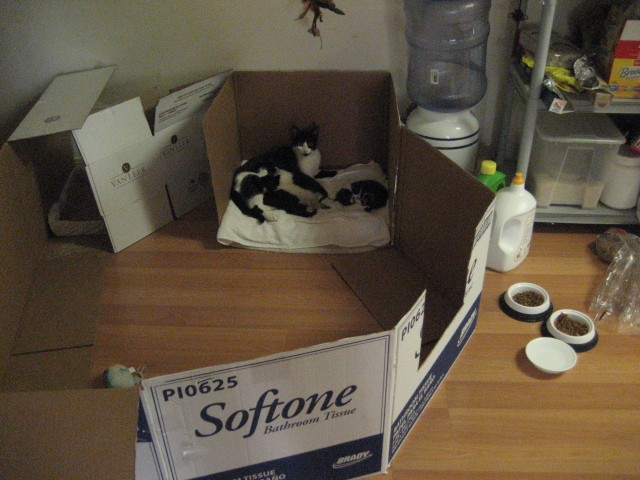 mother cat needs?
Questionplay area
QUESTION: hi Jessica, my mothe
mother cat needs?
Questionplay area
QUESTION: hi Jessica, my mothe
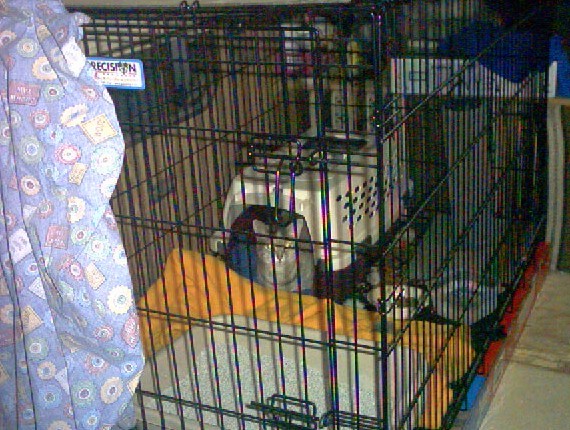 vacation house and taking cat
Questionour permanent home is on a 3 acre semi wooded p
vacation house and taking cat
Questionour permanent home is on a 3 acre semi wooded p
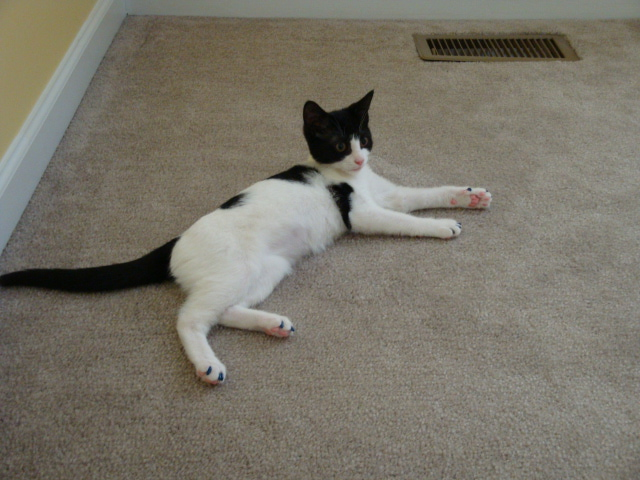 Cat training/Runs away whenever downstairs
Question
Kairi in her room
Hi there!
I recently
Cat training/Runs away whenever downstairs
Question
Kairi in her room
Hi there!
I recently
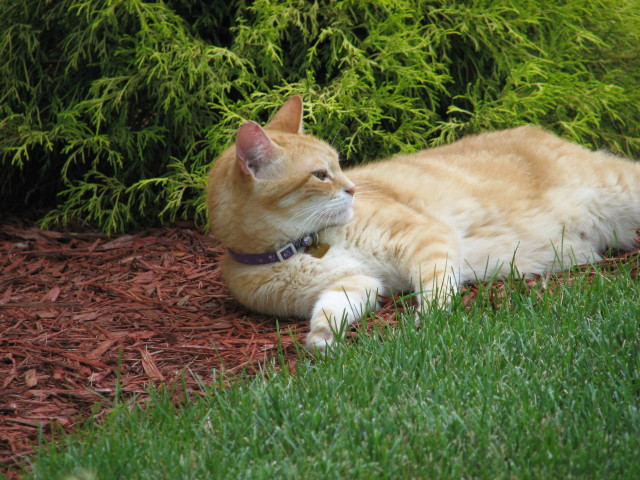 18 yr old male cat
Question
Simon at 13 years
My cat is 18 years ol
18 yr old male cat
Question
Simon at 13 years
My cat is 18 years ol
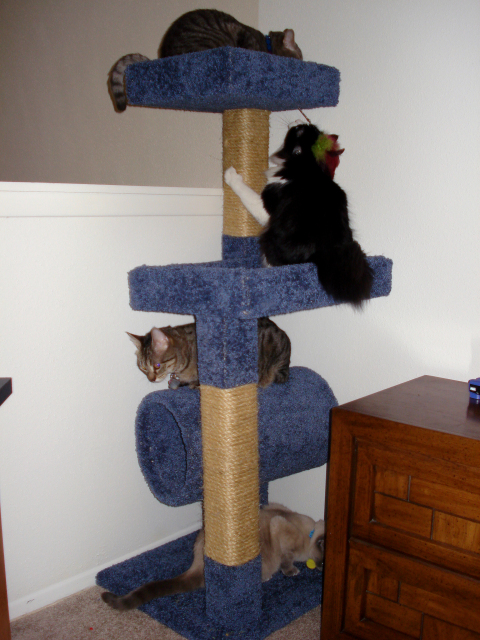 Cat and Dog Introductions
QuestionHi!
I recently acquired a tortie; although I wa
Cat and Dog Introductions
QuestionHi!
I recently acquired a tortie; although I wa